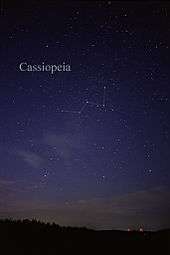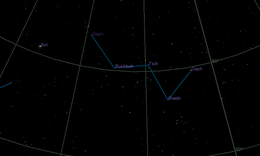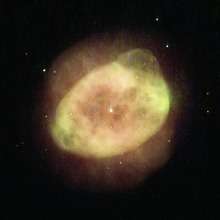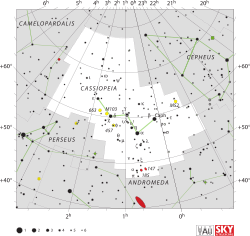Cassiopeia (constellation)
| Constellation | |
|
| |
| Abbreviation | Cas |
|---|---|
| Genitive | Cassiopeiae |
| Pronunciation |
/ˌkæsiəˈpiːə, -sioʊ-/ Cássiopéia, esp. for the constellation also /ˌkæsiˈoʊpiə/[1] Cássiópeia; genitive /ˌkæsiəˈpiːaɪ, -sioʊ-, -iː/[2] |
| Symbolism | the Seated Queen |
| Right ascension | 22h 57m 04.5897s–03h 41m 14.0997s[3] |
| Declination | 77.6923447°–48.6632690°[3] |
| Family | Perseus |
| Area | 598 sq. deg. (25th) |
| Main stars | 5 |
| Bayer/Flamsteed stars | 53 |
| Stars with planets | 14 |
| Stars brighter than 3.00m | 4 |
| Stars within 10.00 pc (32.62 ly) | 7 |
| Brightest star | α Cas (Schedar)[lower-alpha 1] (2.24m) |
| Nearest star |
η Cas (Achird) (19.42 ly, 5.95 pc) |
| Messier objects | 2 |
| Meteor showers | Perseids |
| Bordering constellations |
Camelopardalis Cepheus Lacerta Andromeda Perseus |
|
Visible at latitudes between +90° and −20°. Best visible at 21:00 (9 p.m.) during the month of November. | |
Cassiopeia is a constellation in the northern sky, named after the vain queen Cassiopeia in Greek mythology, who boasted about her unrivalled beauty. Cassiopeia was one of the 48 constellations listed by the 2nd-century Greek astronomer Ptolemy, and it remains one of the 88 modern constellations today. It is easily recognizable due to its distinctive 'W' shape, formed by five bright stars. It is opposite the Big Dipper. In northern locations above 34ºN latitude it is visible year-round and in the (sub)tropics it can be seen at its clearest from September to early November. Even in low southern latitudes below 25ºS it can be seen low in the North.
At magnitude 2.2, Alpha Cassiopeiae, or Schedar, is generally the brightest star in Cassiopeia, though is often shaded by Gamma Cassiopeiae, which has brightened to magnitude 1.6 on occasion. The constellation hosts some of the most luminous stars known, including the yellow hypergiants Rho Cassiopeiae and V509 Cassiopeiae and white hypergiant 6 Cassiopeiae. The semiregular variable PZ Cassiopeiae is one of the largest known stars. In 1572, Tycho Brahe's supernova flared brightly in Cassiopeiae. Fourteen star systems have been found to have exoplanets, one of which—HR 8832—is thought to host seven planets.
Characteristics
Covering 598.4 square degrees and hence 1.451% of the sky, Cassiopeia ranks 25th of the 88 constellations in area.[4] It is bordered by Cepheus to the north and west, Andromeda to the south and west, Perseus to the southeast and Camelopardalis to the east, and also shares a short border with Lacerta to the west.
The three-letter abbreviation for the constellation, as adopted by the International Astronomical Union in 1922, is 'Cas'.[5] The official constellation boundaries, as set by Eugène Delporte in 1930,[lower-alpha 2] are defined by a polygon of 30 segments (illustrated in infobox). In the equatorial coordinate system, the right ascension coordinates of these borders lie between 00h 27m 03s and 23h 41m 06s, while the declination coordinates are between 77.69° and 46.68°.[3] Its position in the Northern Celestial Hemisphere means that the whole constellation is visible to observers north of 12°S.[4][lower-alpha 3]
Features
Stars

The German cartographer Johann Bayer used the Greek letters Alpha through Omega, and then A and B, to label the most prominent 26 stars in the constellation. Upsilon was later found to be two stars and labelled Upsilon1 and Upsilon2 by John Flamsteed. B Cassiopeiae was in fact the supernova known as Tycho's Supernova.[7] Within the constellation's borders, there are 157 stars brighter than or equal to apparent magnitude 6.5.[lower-alpha 4][4]
Alpha Cassiopeiae, traditionally called Schedar (from the Arabic Al Sadr, "the breast"), is a multiple star. The primary is an orange-hued giant of magnitude 2.2, 228 ± 2 light-years from Earth.[9] With a luminosity of around 771 times that of the Sun, it has swollen and cooled after exhausting its core hydrogen over its 100 to 200 million-year lifespan, spending much of it as a blue-white b-type main-sequence star.[10] The brightest companion is a magnitude 8.9 yellow dwarf widely separated from the primary, while two other companions are closer and magnitudes 13 and 14 respectively.[11]
Beta Cassiopeiae, or Caph (meaning "hand"), is a white-hued star of magnitude 2.3, 54 light-years from Earth.[9] It is a δ Scuti variable with a small amplitude and regular period of 2.4 hours.
Gamma Cassiopeiae is the prototype Gamma Cassiopeiae variable star, a type of variable star has a variable disc of material flung off by the high rotation rate of the star. Gamma Cassiopeiae has a minimum magnitude of 3.0 and a maximum magnitude of 1.6, but is generally near magnitude 2.2, with unpredictable fades and brightenings.
Delta Cassiopeiae, also known as "Ruchbah" or "Rukbat," meaning "knee," is an Algol-type eclipsing binary star. It varies by 0.1 magnitudes around magnitude 2.7; its period is 2 years and 1 month. Ruchbah appears to have a blue-white hue and it is 99 light-years from Earth.[12]
Epsilon Cassiopeiae is a blue-white hued star of magnitude 3.3, 442 light-years from Earth, a Be star and small amplitude variable.
The next seven brightest stars in Cassiopeia are also all confirmed or suspected variable stars, including 50 Cassiopeiae which was not given a Greek letter by Bayer. Eta Cassiopeiae is a binary star with a period of 480 years. The primary is a yellow-hued star of magnitude 3.5 and the secondary is a red-hued star of magnitude 7.5. The system is 19 light-years from Earth. Iota Cassiopeiae is a triple star 142 light-years from Earth. The primary is a white-hued star of magnitude 4.5, the secondary is a yellow-hued star of magnitude 6.9, and the tertiary is a star of magnitude 8.4. The primary and secondary are close together but the primary and tertiary are widely separated.
Among fainter stars, Rho Cassiopeiae is a semi-regular pulsating variable yellow hypergiant, among the most luminous stars in the galaxy at approximately 500,000 L☉. It has a minimum magnitude of 6.2 and a maximum magnitude of 4.1; its period is approximately 320 days. Rho Cassiopeiae is about 10,000 light-years from Earth. Sigma Cassiopeiae is a binary star 1500 light-years from Earth. It has a green-hued primary of magnitude 5.0 and a blue-hued secondary of magnitude 7.3. Psi Cassiopeiae is a triple star 193 light-years from Earth. The primary is an orange-hued giant star of magnitude 4.7 and the secondary is a close pair of stars that appears to be of magnitude 9.0.[12]
Cassiopeia includes V509 Cassiopeiae, a second example of the extremely rare yellow hypergiants, as well as 6 Cassiopeiae which is a hotter white hypergiant. It also hosts PZ Cassiopeiae, one of the largest known stars and a semiregular variable. Tycho Brahe's supernova was visible within Cassiopeiae, and the star Tycho G is thought to have been the donor of the material that triggered that explosion.
'W' asterism
The five brightest stars of Cassiopeia - α, β, γ, δ, and ε - form the characteristic W-shaped asterism. All five are prominent naked eye stars, three are noticeably variable, and a fourth is a suspected low amplitude variable. The asterism is oriented as a W when below Polaris during northern spring and summer nights. In northern winter, and when seen from southern latitudes, it is "above" Polaris (ie. closer to the zenith) and the W appears inverted.
Pattern from Alpha Centauri

If one were able to observe Earth's Sun from Alpha Centauri, the closest star to the Solar System, it would appear in Cassiopeia as a yellow-white 0.5 magnitude star, far brighter than any of the other stars of the constellation. The famous W of Cassiopeia would become a zig-zag pattern with the Sun at the leftmost end, closest to ε Cas.[13]
Deep-sky objects

A rich section of the Milky Way runs through Cassiopeia, stretching from Perseus towards Cygnus, and it contains a number of open clusters, young luminous galactic disc stars, and nebulae.
The Heart Nebula and the Soul Nebula are two neighboring emission nebulae about 7,500 light-years away.
Two Messier objects, M52 (NGC 7654) and M103 (NGC 581), are located in Cassiopeia; both are open clusters. M52, once described as a "kidney-shaped" cluster, contains approximately 100 stars and is 5200 light-years from Earth. Its most prominent member is an orange-hued star of magnitude 8.0 near the cluster's edge. M103 is far poorer than M52, with only about 25 stars included. It is also more distant, at 8200 light-years from Earth. Its most prominent member is actually a closer, superimposed double star; it consists of a 7th-magnitude primary and 10th-magnitude secondary.[12]
The other prominent open clusters in Cassiopeia are NGC 457 and NGC 663, both of which have about 80 stars. NGC 457 is looser, and its brightest member is Phi Cassiopeiae, a white-hued supergiant star of magnitude 5.0. The stars of NGC 457, arrayed in chains, are approximately 10,000 light-years from Earth. NGC 663 is both closer, at 8200 light-years from Earth, and larger, at 0.25 degrees in diameter.[12]
There are two supernova remnants in Cassiopeia. The first, which is unnamed, is the aftermath of the supernova called Tycho's Star. It was observed in 1572 by Tycho Brahe and now exists as a bright object in the radio spectrum.[12] Within the 'W' asterism formed by Cassiopeia’s five major stars lies Cassiopeia A (Cas A). It is the remnant of a supernova that took place approximately 300 years ago (as observed now from Earth; it is 10,000 light-years away),[14] and has the distinction of being the strongest radio source observable outside the Solar System. It was perhaps observed as a faint star in 1680 by John Flamsteed. It was also the subject of the first image returned by the Chandra X-Ray Observatory in the late 1990s. The shell of matter expelled from the star is moving at 4,000 kilometres (2,500 mi) per second; it has a temperature of 30,000 kelvin on average.[14]
NGC 457 is another open cluster in Cassiopeia, also called the E.T. Cluster, the Owl Cluster, and Caldwell 13. The cluster was discovered in 1787 by William Herschel. It has an overall magnitude of 6.4 and is approximately 10,000 light-years from Earth, lying in the Perseus arm of the Milky Way. However, its most prominent member, the double star Phi Cassiopeiae, is far closer - between 1000 and 4000 light-years away. NGC 457 is fairly rich; it is a Shapley class e and Trumpler class I 3 r cluster. It is concentrated towards its center and detached from the star field. It contains more than 100 stars, which vary widely in brightness.[15]
Two members of the Local Group of galaxies are in Cassiopeia. NGC 185 is a magnitude 9.2 elliptical galaxy of type E0, 2 million light-years away. Slightly dimmer and more distant NGC 147 is a magnitude 9.3 elliptical galaxy, like NGC 185 it is an elliptical of type E0; it is 2.3 million light-years from Earth. Though they do not appear in Andromeda, both dwarf galaxies are gravitationally bound to the far larger Andromeda Galaxy.[16]
IC 10 is an irregular galaxy that is the only known starburst galaxy in the Local Group of galaxies.
Meteor shower
The December Phi Cassiopeiids are a recently discovered early December meteor shower that radiates from Cassiopeia. Phi Cassiopeiids are very slow, with an entry velocity of approximately 16.7 kilometers per second. The shower's parent body is a Jupiter family comet, though its specific identity is unknown.[17]
Mythology
.jpg)
The constellation is named after Cassiopeia, the queen of Aethiopia. Cassiopeia was the wife of King Cepheus of Aethiopia and mother of Princess Andromeda. Cepheus and Cassiopeia were placed next to each other among the stars, along with Andromeda. She was placed in the sky as a punishment after enraging Poseidon with the boast that her daughter Andromeda was more beautiful than the Nereids or, alternatively, that she herself was more beautiful than the sea nymphs.[18] She was forced to wheel around the North Celestial Pole on her throne, spending half of her time clinging to it so she does not fall off, and Poseidon decreed that Andromeda should be bound to a rock as prey for the monster Cetus. Andromeda was then rescued by the hero Perseus, whom she later married.[19][20]
Cassiopeia has been variously portrayed throughout her history as a constellation. In Persia, she was drawn by al-Sufi as a queen holding a staff with a crescent moon in her right hand, wearing a crown, as well as a two-humped camel. In France, she was portrayed as having a marble throne and a palm leaf in her left hand, holding her robe in her right hand. This depiction is from Augustin Royer's 1679 atlas.[19]
In the ancient Celtic world Anu was the mother goddess and considered to be the mother of all the gods; the Tuatha de Danann. Other references say that she is the mother earth goddess or the Goddess of fertility. On the Cork Kerry border are two mountains called the Paps of Anu (pap is another word for breast.) On the top of each mountain are stone structures or cairns that when viewed from a distance make the two mountains look like a pair of breasts. Anu was known, in the Celtic World, by several similar names: Danu or Don being the most popular alternatives. She was a Mother-Goddess, the wife of the Sun God, Belenos, and considered to be the ancestor of all the Gods, the Tuatha dé Danann, who found themselves obliged to reside in the Otherworld when Miled brought the Celts to the British Isles. She still looks down on us from the night's sky where she appears as Llys Don, better known as the constellation of Casseopeia.
In non-Western astronomy
In Chinese astronomy, the stars forming the constellation Cassiopeia are found among three areas: the Purple Forbidden enclosure (紫微垣, Zǐ Wēi Yuán), the Black Tortoise of the North (北方玄武, Běi Fāng Xuán Wǔ), and the White Tiger of the West (西方白虎, Xī Fāng Bái Hǔ).
The Chinese astronomers saw several figures in what is modern-day Cassiopeia. Kappa, Eta, and Mu Cassopeiae formed a constellation called the Bridge of the Kings; when seen along with Alpha and Beta Cassiopeiae, they formed the great chariot Wang-Liang. The charioteer's whip was represented by Gamma Cassiopeiae, sometimes called "Tsih", the Chinese word for "whip".[19]
In the 1600s, various Biblical figures were depicted in the stars of Cassiopeia. These included Bathsheba, Solomon's mother; Deborah, an Old Testament prophet; and Mary Magdalene. a disciple of Jesus.[19]
A figure called the "Tinted Hand" also appeared in the stars of Cassiopeia in some Arab atlases. This is variously said to represent a woman's hand dyed red with henna, as well as the bloodied hand of Muhammad's daughter Fatima. The hand is made up of the stars α Cas, β Cas, γ Cas, δ Cas, ε Cas, and η Cas. The arm is made up of the stars α Per, γ Per, δ Per, ε Per, η Per, and ν Per.[19]
Another Arab constellation that incorporated the stars of Cassiopeia was the Camel. Its head was composed of Lambda, Kappa, Iota, and Phi Andromedae; its hump was Beta Cassiopeiae; its body was the rest of Cassiopeia, and the legs were composed of stars in Perseus and Andromeda.[19]
Other cultures see a hand or moose antlers in the pattern.[21] These include the Lapps, for whom the W of Cassiopeia forms an elk antler. The Chukchi of Siberia similarly saw the five main stars as five reindeer stags.[19]
The people of the Marshall Islands saw Cassiopeia as part of a great porpoise constellation. The main stars of Cassiopeia make its tail, Andromeda and Triangulum form its body, and Aries makes its head.[19] In Hawaii, Alpha, Beta, and Gamma Cassiopeiae were named. Alpha Cassiopeiae was called Poloahilani, Beta Cassiopeiae was called Polula, and Gamma Cassiopeiae was called Mulehu. The people of Pukapuka saw the figure of Cassiopeia as a distinct constellation called Na Taki-tolu-a-Mataliki.[22]
In Modern Indian Astronomy Cassiopeia is known as Sharmishtha. In Hindu mythology, Sharmistha, also known as Sharmista or Sharmishtha, was the daughter of the great Devil (Daitya) King Vrishparva. She was also a friend of Devayani (Andromeda) for whom she later becomes a servant.
In popular culture
In the film Contact (1997) starring Jodie Foster and Matthew McConaughey, Foster's character Dr. Eleanor Arroway has the following line of dialogue: "You see that large W-shaped constellation there? That's Cassiopeia. And Cassiopeia A gives off a whole lot of radio signals. I listen to them a lot. It's a remnant of a supernova."
In the 1998 episode of The X-Files, "Patient X", guest starring Veronica Cartwright, Cartwright's character Cassandra Spender, an alien abductee, leaves fingerprints on a window corresponding to the constellation Cassiopeia, a reference to the character's name (she is confined to a wheelchair) as well as an implied origin for the aliens who abducted her.
In the film Serendipity (2001) starring John Cusack and Kate Beckinsale, Cusack tells Beckinsale about the constellation Cassiopeia the night they meet one another after noticing that the freckles on her forearm match the constellation's pattern exactly.
In the Film "The Edge", Anthony Hopkins Character points to Cassiopeia and mentions the two stars forming the last line in the W point to the north.
In the hip-hop musical In the Heights, the smog and light pollution of New York City are referenced by the lyric "Ain't no Cassiopeia in Washington Heights".
In Sara Bareilles' album The Blessed Unrest (2013), the 7th track is titled "Cassiopeia" and is lyrically and metaphorically about the stars. During the making of The Blessed Unrest, she was given a book about astronomy. She found herself fascinated reading about the different constellations, especially Cassiopeia, as well as the topic of supernovas, the incredibly bright bursts of light that stars give off when they explode. Inspired, she penned this song imagining Cassiopeia as a human, and falling in love with another star. "I started to think about how that might feel to personify, you know? The idea of being a star and so far away from everything around you," she told Radio.com "What if a star falls in love? The song is this idea that you give something up to come together."
In "The Fifth Wave" book series by Rick Yancey, the main character and protagonist is named Cassie for Cassiopeia, having been named after it because it was pretty, not because her parents knew the myth.
In the Japan's first super sentai series, Himitsu Sentai Gorenger, Cassiopeia is the constellation whose cosmic rays weaken the main enemy Black Cross Fuhrer and thus was incorporated into Gorenger's finisher. Each syllable of Cassiopeia was also spelled out by the first Japanese letter of each ranger's surname spelling Ka-Shi-O-Pe-A.
Namesakes
USS Cassiopeia (AK-75) was a United States Navy Crater-class cargo ship named after the constellation.
Notes
- ↑ γ Cas is variable and occasionally brighter than α.
- ↑ Delporte had proposed standardising the constellation boundaries to the International Astronomical Union, who had agreed and gave him the lead role[6]
- ↑ While parts of the constellation technically rise above the horizon to observers between the latitudes of 12°S and 43°S, stars within a few degrees of the horizon are to all intents and purposes unobservable.[4]
- ↑ Objects of magnitude 6.5 are among the faintest visible to the unaided eye in suburban-rural transition night skies.[8]
References
- ↑ Jones, Daniel (2003) [1917], Peter Roach, James Hartmann and Jane Setter, eds., English Pronouncing Dictionary, Cambridge: Cambridge University Press, ISBN 3-12-539683-2
- ↑ "Cassiopeia". Oxford Dictionaries. Oxford University Press. Retrieved 2016-01-20.
- 1 2 3 "Cassiopeia, Constellation Boundary". The Constellations. International Astronomical Union. Retrieved 2 December 2016.
- 1 2 3 4 Ian Ridpath. "Constellations: Andromeda–Indus". Star Tales. self-published. Retrieved 2 December 2016.
- ↑ Russell, Henry Norris (1922). "The New International Symbols for the Constellations". Popular Astronomy. 30: 469. Bibcode:1922PA.....30..469R.
- ↑ Ridpath, Ian. "Constellation boundaries: How the modern constellation outlines came to be". Star Tales. self-published. Retrieved 1 June 2016.
- ↑ Wagman, Morton (2003). Lost Stars: Lost, Missing and Troublesome Stars from the Catalogues of Johannes Bayer, Nicholas Louis de Lacaille, John Flamsteed, and Sundry Others. Blacksburg, Virginia: The McDonald & Woodward Publishing Company. pp. 91–92. ISBN 978-0-939923-78-6.
- ↑ Bortle, John E. (February 2001). "The Bortle Dark-Sky Scale". Sky & Telescope. Sky Publishing Corporation. Retrieved 6 June 2015.
- 1 2 van Leeuwen, F. (2007). "Validation of the New Hipparcos Reduction". Astronomy and Astrophysics. 474 (2): 653–64. arXiv:0708.1752
 . Bibcode:2007A&A...474..653V. doi:10.1051/0004-6361:20078357.
. Bibcode:2007A&A...474..653V. doi:10.1051/0004-6361:20078357. - ↑ Professor James B. (Jim) Kaler. "SHEDAR (Alpha Cassiopeiae)". University of Illinois. Archived from the original on 27 March 2010. Retrieved 2010-02-22.
- ↑ Mason, Brian D.; Wycoff, Gary L.; Hartkopf, William I.; Douglass, Geoffrey G.; Worley, Charles E. (2001). "The 2001 US Naval Observatory Double Star CD-ROM. I. The Washington Double Star Catalog". The Astronomical Journal. 122 (6): 3466. Bibcode:2001AJ....122.3466M. doi:10.1086/323920.
- 1 2 3 4 5 Ridpath & Tirion 2001, pp. 106-108.
- ↑ Dole, Stephen H.; Asimov, Isaac (1964). "Planets for man". New York. Bibcode:1964plma.book.....D.
- 1 2 Wilkins, Jamie; Dunn, Robert (2006). 300 Astronomical Objects: A Visual Reference to the Universe (1st ed.). Buffalo, New York: Firefly Books. ISBN 978-1-55407-175-3.
- ↑ Levy 2005, pp. 92-93.
- ↑ Levy 2005, pp. 180-181.
- ↑ Jenniskens, Peter (September 2012). "Mapping Meteoroid Orbits: New Meteor Showers Discovered". Sky & Telescope: 25.
- ↑ Chen, P.K. (2007). A Constellation Album: Stars and Mythology of the Night Sky. p. 82. ISBN 9781931559386.
- 1 2 3 4 5 6 7 8 Staal 1988, pp. 14–18
- ↑ Chen 2007, pp. 82–83
- ↑ Ptak, Robert (1998). Sky Stories Ancient and Modern. New York: Nova Science Publishers. p. 104.
- ↑ Makemson, Maud Worcester (1941). The Morning Star Rises: an account of Polynesian astronomy. Yale University Press. p. 281.
Bibliography
- Krause, O; Rieke, GH; Birkmann, SM; Le Floc'h, E; Gordon, KD; Egami, E; Bieging, J; Hughes, JP; Young, ET; Hinz, JL; Quanz, SP; Hines, DC (2005). "Infrared echoes near the supernova remnant Cassiopeia A". Science. 308 (5728): 1604–6. arXiv:astro-ph/0506186
 . Bibcode:2005Sci...308.1604K. doi:10.1126/science.1112035. PMID 15947181.
. Bibcode:2005Sci...308.1604K. doi:10.1126/science.1112035. PMID 15947181. - Levy, David H. (2005), Deep Sky Objects, Prometheus Books, ISBN 1-59102-361-0
- Ridpath, Ian; Tirion, Wil (2001), Stars and Planets Guide, Princeton University Press, ISBN 0-691-08913-2
- Ridpath, Ian; Tirion, Wil (2007). Stars and Planets Guide. London: Collins. ISBN 978-0-00-725120-9.
- Staal, Julius D. W. (1988). The New Patterns in the Sky: Myths and Legends of the Stars. The McDonald and Woodward Publishing Company. ISBN 978-0-939923-04-5.
External links
| Wikimedia Commons has media related to: |
- The Deep Photographic Guide to the Constellations: Cassiopeia
- The clickable Cassiopeia
- Star Tales – Cassiopeia
- Cassiopeia Constellation at Constellation Guide
- Warburg Institute Iconographic Database (over 150 medieval and early modern images of Cassiopeia)
Coordinates: ![]() 01h 00m 00s, +60° 00′ 00″
01h 00m 00s, +60° 00′ 00″
